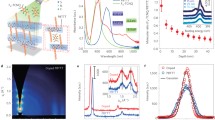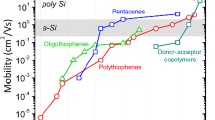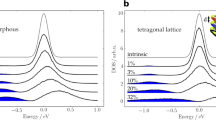Abstract
Charge transport in semiconducting polymers ranges from localized (hop**-like) to delocalized (metal-like), yet no quantitative model exists to fully capture this transport spectrum and its dependency on charge carrier density. In this study, using an archetypal polymer–dopant system, we measure the temperature-dependent electrical conductivity, Seebeck coefficient and extent of oxidation. We then use these measurements to develop a semi-localized transport (SLoT) model, which captures both localized and delocalized transport contributions. By applying the SLoT model to published data, we demonstrate its broad utility. We are able to determine system-dependent parameters such as the maximum localization energy of the system, how this localization energy changes with do**, the amount of dopant required to achieve metal-like conductivity and the conductivity a system could have in the absence of localization effects. This proposed SLoT model improves our ability to predict and tailor electronic properties of doped semiconducting polymers.




Similar content being viewed by others
Data availability
Source data are provided with this paper. The collected datasets are included in this published article, and additional datasets that have been analysed are from cited literature. Furthermore, to assist in the dissemination of the SLoT model, we provide a supplemental Excel worksheet (Supplementary Data 1) with the P3HT–FeCl3 production data, an s = 1 lookup table and auto-fill equations and plots. Calculus and numerical methods are not required to implement equations (1)–(5) from the SLoT model with this Excel worksheet. In addition, for convenience, any additional datasets generated and analysed during the current study will also be made available from the corresponding authors upon reasonable request.
References
Russ, B., Glaudell, A., Urban, J. J., Chabinyc, M. L. & Segalman, R. A. Organic thermoelectric materials for energy harvesting and temperature control. Nat. Rev. Mater. 1, 16050 (2016).
Bubnova, O. & Crispin, X. Towards polymer-based organic thermoelectric generators. Energy Environ. Sci. 5, 9345–9362 (2012).
Skotheim, T. et al. (eds) Handbook of Conducting Polymers 2nd edn (CRC Press, 1997).
Gregory, S. A. et al. Effect of heteroatom and do** on the thermoelectric properties of poly(3-alkylchalcogenophenes). Adv. Energy Mater. 8, 1802419 (2018).
Mott, N. F. & Davis, E. A. Electronic Processes in Non-Crystalline Materials 2nd edn (Oxford Univ. Press, 2012).
Mott, N. F. Conduction in glasses containing metal ions. J. Non-Cryst. Solids 1, 1–17 (1968).
Menon, A. K. et al. Metallo-organic n-type thermoelectrics: emphasizing advances in nickel-ethenetetrathiolates. J. Appl. Polym. Sci. https://doi.org/10.1002/app.44402 (2017).
Menon, A. K., Wolfe, R. M. W., Marder, S. R., Reynolds, J. R. & Yee, S. K. Systematic power factor enhancement in n-type NiETT/PVDF composite films. Adv. Funct. Mater. 28, 1801620 (2018).
Xuan, Y. et al. Thermoelectric properties of conducting polymers: the case of poly(3-hexylthiophene). Phys. Rev. B 82, 115454 (2010).
Epstein, A. J. et al. Insulator-to-metal transition in polyaniline: effect of protonation in emeraldine. Synth. Met. 21, 63–70 (1987).
Watanabe, S. et al. Validity of the Mott formula and the origin of thermopower in π-conjugated semicrystalline polymers. Phys. Rev. B 100, 241201 (2019).
Kim, E.-G. et al. Charge transport parameters of the pentathienoacene crystal. J. Am. Chem. Soc. 129, 13072–13081 (2007).
Tanaka, H. et al. Thermoelectric properties of a semicrystalline polymer doped beyond the insulator-to-metal transition by electrolyte gating. Sci. Adv. 6, eaay8065 (2020).
Glaudell, A. M., Cochran, J. E., Patel, S. N. & Chabinyc, M. L. Impact of the do** method on conductivity and thermopower in semiconducting polythiophenes. Adv. Energy Mater. 5, 1401072 (2015).
Abutaha, A. et al. Correlating charge and thermoelectric transport to paracrystallinity in conducting polymers. Nat. Commun. 11, 1737 (2020).
Mott, N. F. The mobility edge since 1967. J. Phys. C 20, 3075–3102 (1987).
Ashcroft, N. Solid State Physics (Thomson Press, 2003).
Statz, M. et al. On the manifestation of electron-electron interactions in the thermoelectric response of semicrystalline conjugated polymers with low energetic disorder. Commun. Phys. 1, 16 (2018).
Zeier, W. G. et al. Thinking like a chemist: intuition in thermoelectric materials. Angew. Chem. Int. Ed. 55, 6826–6841 (2016).
Blackburn, J. L. et al. Intrinsic and extrinsically limited thermoelectric transport within semiconducting single‐walled carbon nanotube networks. Adv. Electron. Mater. 5, 1800910 (2019).
Kang, S. D. & Snyder, G. J. Charge-transport model for conducting polymers. Nat. Mater. 16, 252–257 (2017).
Thomas, E. M., Popere, B. C., Fang, H., Chabinyc, M. L. & Segalman, R. A. Role of disorder induced by do** on the thermoelectric properties of semiconducting polymers. Chem. Mater. 30, 2965–2972 (2018).
Zevalkink, A. et al. A practical field guide to thermoelectrics: fundamentals, synthesis, and characterization. Appl. Phys. Rev. 5, 021303 (2018).
Boyle, C. J. et al. Tuning charge transport dynamics via clustering of do** in organic semiconductor thin films. Nat. Commun. 10, 2827 (2019).
Al Kurdi, K. et al. Electron transport in a sequentially doped naphthalene diimide polymer. Mater. Adv. 1, 1829–1834 (2020).
Un, H.-I. et al. Understanding the effects of molecular dopant on n-type organic thermoelectric properties. Adv. Energy Mater. 9, 1900817 (2019).
Kang, K. et al. Investigation of the thermoelectric response in conducting polymers doped by solid-state diffusion. Mater. Today Phys. 8, 112–122 (2019).
Lee, Y., Park, J., Son, J., Woo, H. Y. & Kwak, J. Degenerately doped semi‐crystalline polymers for high performance thermoelectrics. Adv. Funct. Mater. 31, 2006900 (2021).
Bredas, J. L. & Street, G. B. Polarons, bipolarons, and solitons in conducting polymers. Acc. Chem. Res. 18, 309–315 (1985).
Barbara, P. F., Meyer, T. J. & Ratner, M. A. Contemporary issues in electron transfer research. J. Phys. Chem. 100, 13148–13168 (1996).
Marcus, R. A. Electron transfer reactions in chemistry: theory and experiment (Nobel Lecture). Angew. Chem. Int. Ed. 32, 1111–1122 (1993).
Snyder, G. J. et al. Weighted mobility. Adv. Mater. 32, 2001537 (2020).
Shallcross, R. C. et al. Quantifying the extent of contact do** at the interface between high work function electrical contacts and poly(3-hexylthiophene) (P3HT). J. Phys. Chem. Lett. 6, 1303–1309 (2015).
Kolesov, V. A. et al. Solution-based electrical do** of semiconducting polymer films over a limited depth. Nat. Mater. 16, 474–480 (2017).
Neusser, D. et al. High conductivities of disordered P3HT films by an electrochemical do** strategy. Chem. Mater. 32, 6003–6013 (2020).
Vijayakumar, V. et al. Bringing conducting polymers to high order: toward conductivities beyond 105 S cm−1 and thermoelectric power factors of 2 mW m−1 K−2. Adv. Energy Mater. 9, 1900266 (2019).
Basescu, N. et al. High electrical conductivity in doped polyacetylene. Nature 327, 403–405 (1987).
Przybylski, M., Bulka, B. R., Kulszewicz, I. & Proń, A. Electrical transport properties of polyacetylene tetrachloroferrate. Solid State Commun. 48, 893–896 (1983).
Kaiser, A. B. Thermoelectric power and conductivity of heterogeneous conducting polymers. Phys. Rev. B 40, 2806–2813 (1989).
Jones, T. E., Ogden, T. R., McGinnis, W. C., Butler, W. F. & Gottfredson, D. M. Electronic properties of polyacetylene doped with FeCl3. J. Chem. Phys. 83, 2532–2537 (1985).
Chiang, C. K. et al. Electrical conductivity in doped polyacetylene. Phys. Rev. Lett. 39, 1098–1101 (1977).
Chiang, C. K. et al. Conducting polymers: halogen doped polyacetylene. J. Chem. Phys. 69, 5098–5104 (1978).
Park, Y.-W., Heeger, A. J., Druy, M. A. & MacDiarmid, A. G. Electrical transport in doped polyacetylene. J. Chem. Phys. 73, 946–957 (1980).
Bubnova, O. et al. Optimization of the thermoelectric figure of merit in the conducting polymer poly(3,4-ethylenedioxythiophene). Nat. Mater. 10, 429–433 (2011).
Bubnova, O. et al. Semi-metallic polymers. Nat. Mater. 13, 190–194 (2014).
Pittelli, S. L. et al. Structural effects on the charge transport properties of chemically and electrochemically doped dioxythiophene polymers. J. Mater. Chem. C 8, 683–693 (2020).
Pittelli, S. L., Gregory, S. A., Ponder, J. F.Jr, Yee, S. K. & Reynolds, J. R. Inducing planarity in redox-active conjugated polymers with solubilizing 3,6-dialkoxy-thieno[3,2-b]thiophenes (DOTTs) for redox and solid-state conductivity applications. J. Mater. Chem. C 8, 7463–7475 (2020).
Ponder, J. F. Jr. et al. Conductive, solution-processed dioxythiophene copolymers for thermoelectric and transparent electrode applications. Adv. Energy Mater. 9, 1900395 (2019).
Bubnova, O., Berggren, M. & Crispin, X. Tuning the thermoelectric properties of conducting polymers in an electrochemical transistor. J. Am. Chem. Soc. 134, 16456–16459 (2012).
Acknowledgements
S.A.G. appreciates the partial support from the Office of Naval Research (award no. N00014-19-1-2162), the Department of Education Graduate Assistance in Areas of National Need (GAANN) programme at the Georgia Institute of Technology (award no. P200A180075), the Link Energy Foundation, and the Science and Technology of Material Interfaces (STAMI) group at the Georgia Institute of Technology. J.M.R. is grateful for partial support from the Office of Naval Research (award no. N00014-19-1-2162) and the GAANN program at Georgia Institute of Technology (award no. P200A180075). S.A.G. thanks J. F. Ponder Jr for a critical review and feedback. A.A. appreciates the support from the National Science Foundation (NSF) Graduate Research Fellowship (grant no. DGE-1650044). J.P.W. acknowledges support from the NSF Graduate Research Fellowship (grant no. DGE-1650044). A.K.M. acknowledges funding support from the ITRI-Rosenfeld Fellowship from the Energy Technologies Area at Lawrence Berkeley National Laboratory. G.J.S. thanks the NSF Designing Materials to Revolutionize and Engineer our Future (DMREF) programme (award no. 1729487). S.K.Y. is grateful for partial support from support the Office of Naval Research (award no. N00014-19-1-2162). Part of this work (XPS analysis) was performed in part at the Georgia Tech Institute for Electronics and Nanotechnology, a member of the National Nanotechnology Coordinated Infrastructure, which is supported by the NSF (grant no. ECCS-1542174). Any opinions, findings and conclusions or recommendations expressed in this material are those of the authors and do not necessarily reflect the views of the NSF.
Author information
Authors and Affiliations
Contributions
S.A.G. conceptualized and coordinated the project, led charge transport measurements and authorship, and together with R.H. developed the SLoT model. R.H. conducted numerical modelling, prepared figures and manuscript and provided advice. A.A. and J.M.R. performed charge transport measurements and assisted with manuscript preparation. J.P.W. performed XPS measurements and analysis and assisted with manuscript preparation. A.K.M. guided the early formulation of the SLoT model and reviewed the manuscript. M.D.L. provided guidance to S.A.G. and J.P.W. for the XPS analysis and to S.A.G. for thermal and carrier property relationships. G.J.S. provided insight and reviewed the model and manuscript. S.K.Y. initially motivated the investigation, provided overall guidance and advice to the project, commented on the SLoT model development and reviewed and edited the manuscript.
Corresponding authors
Ethics declarations
Competing interests
The authors declare no competing interests.
Additional information
Peer review information Nature Materials thanks Denis Andrienko and the other, anonymous, reviewer(s) for their contribution to the peer review of this work.
Publisher’s note Springer Nature remains neutral with regard to jurisdictional claims in published maps and institutional affiliations.
Supplementary information
Supplementary Information
Supplementary Notes 1–5.
Supplementary Data 1
SLoT model lookup table, algebraic transport computations and compiled thermoelectric data.
Source data
Source Data Fig. 2
XPS spectral data for Fig. 2.
Rights and permissions
About this article
Cite this article
Gregory, S.A., Hanus, R., Atassi, A. et al. Quantifying charge carrier localization in chemically doped semiconducting polymers. Nat. Mater. 20, 1414–1421 (2021). https://doi.org/10.1038/s41563-021-01008-0
Received:
Accepted:
Published:
Issue Date:
DOI: https://doi.org/10.1038/s41563-021-01008-0
- Springer Nature Limited
This article is cited by
-
Counterion docking: a general approach to reducing energetic disorder in doped polymeric semiconductors
Nature Communications (2024)
-
Heterogeneous Oriented Structure model of thermoelectric transport in conducting polymers
Scientific Reports (2023)
-
Amplitude-mode spectroscopy of chemically injected and photogenerated charge carriers in semiconducting single-walled carbon nanotubes
Nano Research (2023)





